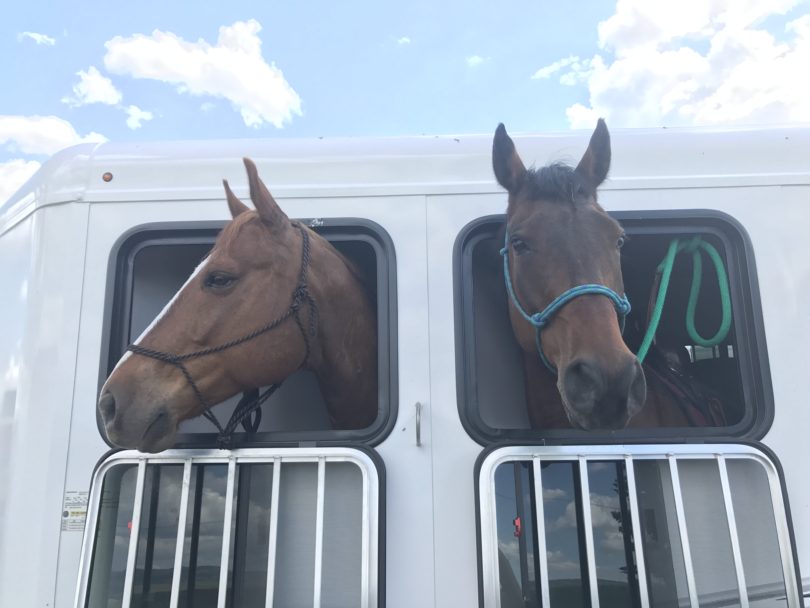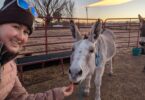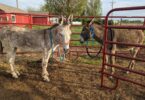Seatbelts and Good Knots, Two Keys to Safe Horse Hauling
Whether you’re trailering for a short distance or long haul (pun intended), it’s important to keep safety top-of-mind. Tying your horse safely in the trailer is one critical component to keeping them safe on your journey.
When you arrive at your destination, make sure you also know how to tie your horse to a hitching post.
Struggle to remember how to tie different knots or want to learn more? Pick up a set of my favorite horse tying pocket guide — Reference Ready: Essential Horse Knots.
First Things First
To begin, let’s discuss some basics about horse trailer design:
- There are two main types of horse trailers when it comes to attaching to towing vehicles: bumper-pull and gooseneck.
- When it comes to how horses are loaded, trailers can be straight-load, slant load, or stock.
- In a stock trailer, a horse may be hauled loose or tied.
- Horses should always face forward in a straight-load trailer.
- In a slant-load trailer, horses should face forward and toward the middle of the road.
Learn (a lot) more about these structural and design differences in our article about horse trailer weights.
New to trailering? Check out our article about trailering horses for the first time.
Trailer Tying 101
There are countless things to think about when hauling horses. We talk you through the most important ones in our article about trailering horses for the first time.
One of the most important things you need to know is how you safely secure your horse in a trailer.
What You Can Use
There are two primary methods for trailer tying:
- Lead Rope: If you use a lead rope, be sure to tie it using a quick release knot. This way, if the horse panics and pulls back, you can free him quickly.
- Trailer Tie: If you use a trailer tie, clip the quick release snap to the trailer and the regular clip end to the horse’s halter. If something goes wrong, it’s easier to detach the part connected to the trailer hook than the end connected to a panicked animal.
Note: You may prefer using a design like the Tie Safe Trailer Tie from Intrepid International, which features velcro that detaches on its own if the horse pulls back strongly enough.
Of the two options, I prefer a trailer tie. I’ve had a few horses that like to chew on lead ropes, so I prefer a heavy-duty rubber trailer tie with a quick release end.
If you choose to use a lead rope, though, check out this video from AQHA showing how to tie quick release safety knots.
How High to Tie
If you tie a horse too low, it may be able to get a leg over the rope and become seriously injured, especially in a confined space like a trailer.
For safety, always tie a horse at wither-height or higher.
Horses should be tied with enough length to hold their heads naturally, but not move around too much. They should definitely not be able to reach the ground with their heads.
Generally, in a horse trailer, tie rings are pre-installed at an adequate height — usually above the windows. Always check though! I’ve looked at brand-new trailers with tie rings installed below the windows.
Lower rings might work if you’re hauling mini horses, or a smaller stock animal such as a llama, but that is too low for an average-sized horse.
Adding Hay to the Mix
Your horse may not be the only thing you tie in the trailer. Some people like to haul with a hay bag or hay net so the horse has something to munch on during a trip, especially on longer hauls.
If you want to offer hay, be sure to tie the net or bag as high as possible—at a minimum, wither height.
If possible, tie it using a quick release knot, or use a metal snap to clip to something breakable, rather than straight to a built-in trailer tie ring.
For example, you could tie a bit of baling twine to the ring, and then clip the hay bag to the twine. This way, if the horse manages to get caught up in the hay net, he can still break free.
 Always Be Prepared
Always Be Prepared
Even experienced horse people, who have been tying safely for many years, aren’t immune from accidents.
Whenever you’re hauling, keep a pocket knife handy. It can be used to free the horse if he gets caught.
Once, my horse managed to get his hoof stuck in a hay net, even though the net was tied as high as I could get it. Fortunately, I noticed it right away and was able to cut the horse free with my pocket knife before any injury occurred.
After this experience I stopped hauling him with a hay net. For this particular horse, it was more of a safety hazard.
When in doubt, consult a trusted trainer or veteran horse owner for trailer tying advice, keep an equine knot tying guide on-hand, and double-check your knots. Better safe than sorry!
P.S. Enjoy this article? Trot on over to:
- Horses & Hitching Posts: How to Tie Right Every Time
- Shipping Boots vs. Standing Wraps – What Do I Use?
- Corral Cards Review: Horse Knot Tying Pocket Guide
- Trailering a Horse for the First Time: You CAN Do This
- Peace of Mind Horse Trailering (Tadi Brothers Camera Review)
- 10 Best Bumper Pull Horse Trailer Brands of All Time
- Horse Trailer Weight by the Numbers: 63 Types & Models
- Horseback Riding Safety Equipment That’s Worth Every Penny
- 7 Best Safety Stirrups for Adults
- Why Western Riders Don’t Wear Helmets









